Statecharts
Many situations require the simulation of complex behaviour patterns, in my case for use in artificial life programs. State-transition diagrams may seem a suitable modelling tool for this. For those who are unfamiliar with these here is a diagram representing the behaviour of a simple opponent in a computer game. In a state-transition diagram each node represents a single state and each arrow a transition between states caused by an event.
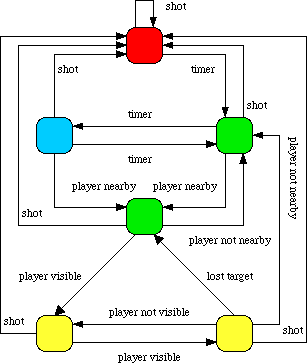
Lets call the player Ann and the computer opponent Bob for wont of better names. Bob has four basic behaviours: stationary blue, random green, hunting yellow, and fleeing red. He starts his life in stationary blue behaviour and waits for a significant event to occur. In this case that means one of a timer going off, Ann approaching, or being shot.
After a certain amount of time waiting in stationary blue a timer will go off and triggering a change in state to random green and Bob will start to move aimlessly about. This state prevents the world going into stasis when Ann is not around. At any one time most of Bob's fellows just stand there but occasionally somebody will move to a new location. Relevant events for this state are similar to that for stationary blue. The only difference is a separate timer setting.
Lets say Ann approaches, Bob is informed she is in the area and moves to another random green state. Behaviour is the same as before but different events become relevant. Now Bob will respond to seeing Ann, her leaving the area, and again being shot. If she leaves then he changes back to the previous state. If Bob spots Ann however he will change to hunting yellow and home in on her, intent on doing her harm or giving her a box of chocolates, whatever the game decrees.
While hunting Bob may loose sight of his target. He will move to his backup behaviour and now hunt the location she was last seen. Hopefully when he arrives she will be visible again and the purposeful hunt can continue. If she does not become visible when he arrives at her last position then he will move back to a random green state.
Being shot is an important event, Bob will respond to it no matter what state he is in. When shot Bob turns coward and changes to a fleeing red behaviour. He will keep running until a reasonable time has passed. If he is shot he will start running again and the timer is reset. Eventually he calms down and will change back to random green movement.
All the details of Bob's behaviour are caught in the state-transition diagram but there are some aspects which are less than desirable. There are a number of duplicate event transitions, including many shoot events. This is a simple behaviour with more complex ones the number of nodes and event transitions will grow and the state-transition diagrams will grow large and unwieldy.
The alternative I propose was first introduced to me in the context of real-time system design. Statecharts add the concepts of hierarchy and concurrency which reduce the above problems. Hierarchy allows super-behaviours to be defined, nodes which can themselves be described by smaller statecharts. Simple behaviours can be viewed on a single page or complex behaviours split easily onto several pages. Concurrency allows multiple behaviours to be applied to a single object. Although not required in the example above it could be used to control another aspect of Bob, say his appearance.
Hierarchy is shown by enclosing state nodes with common features within higher level nodes (or rounded rectangles in this case).
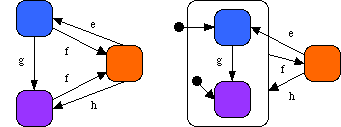
Arrows starting with black circles indicate the starting node for that level of the diagram. So the initial node in this example is blue. If in either the blue or magenta sub-node the response to event f is a transition to orange. From there an e transition takes it back to blue and an h transition takes it back to orange, through one default behaviour arrow.
Concurrency is shown by separating a high level node into two concurrent parts, the dotted line separates concurrent nodes.
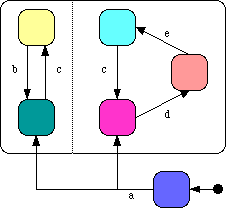
Mauve is the stating node and control stays there until event a. Then it splits into two control flows, one going to aqua, the other to pink. The first thread of control will flip back and forth between aqua and pastel yellow depending on the occurrence of b and c. Independent of this the second control thread rotates between three nodes - pink, rose, and cyan - dependent on the d, e, and c events. Notice that each thread monitors the c event giving some degree of synchronisation between them.
Now back to Bob and his more complex behaviour. Here it is converted into a statechart with the same states and events as before but a few layers of hierarchy added.
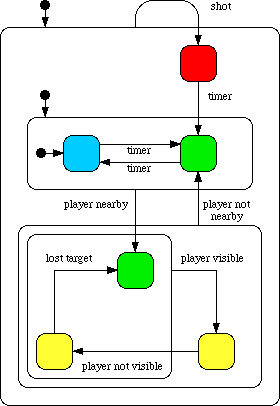
Notice the slightly peculiar action at the top. No matter what state Bob is in, even when it is fleeing red, when he is shot he moves to fleeing red and resets the associated timer. This diagram is more compact and it is much harder to get lost in the diagram whereas it is quite easy with all the event lines in a state-transition diagram.
Design Tools
I am not sure what is the normal procedure for developing behaviour patterns for such things as computer controlled opponents but these statecharts offer an easy option. Given a set of basic behaviour - like those defined for Bob - and some events we can build up complex behaviour quickly. Imagine a design tool with a palette of behaviours. Drop a few of these onto the work area and connect them up with some standard events and you are ready to test. Set up a concurrent thread alongside to control another aspect of his personality. Adding a few levels of hierarchy is easy, just enclose some nodes with the rectangle tool. A few adjustments, drag nodes into a lower level of the hierarchy and the enclosing rectangle expands to fit. It might even be possible to see the behaviour as it was executed and make modifications at the same time.
Behavioural Implementation
As well as offering behavioural descriptions the hierarchical nature of statecharts gives us a clue to an efficient implementation of the same behaviour. Statecharts can be described by a tree in which each parent node has multiple child nodes. A systems current behaviour can be stored by a pointer to the correct node in the tree. The correct action at any particular time does not have to be looked up in a big table it is readily available at the end of the pointer.
Associated with each node are a number of event transitions. When an event occurs a search starts with those event transitions at the current node. If there is not a match then the search moves up to the events in the parent node and so on until the root is reached. If an event transition matching the event is found then it specifies the next current node. Assuming events are stored in a linked list then the tail end of a child's event list could be connected to the front end of its parent's event list. Searching for all appropriate events would be a single linked list search.
Here is Bob's behaviour again but this time as a tree. In a similar way to statecharts the black circle is used to indicate default behaviour. Black arrows show event transitions and gray arrows show linkage between child and parent node.
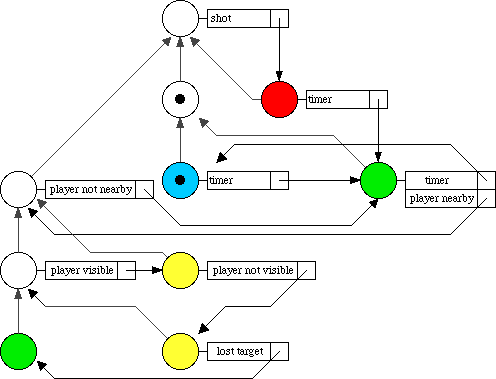
Genetic Algorithm
A tree based behavioural implementation is also suitable for my pet artificial intelligence technique - genetic algorithms (see my senior honours project for details). These would work on populations of behaviours, testing to see how well they do their job. Some of the best of the current set are taken and mutated or combined with each other to produce new and hopefully better behaviours. I do not see how combination could be done but mutation is a matter of making small changes to nodes, events, and transitions. Various possibilities are shown here:
- move node up one level
- move node down one level
- move default behaviour to sibling node
- duplicate node
- remove duplicate node
- redirect transition arrow up one level
- redirect transition arrow down one level
- redirect transition arrow to sibling node
- move event up one level
- move event down one level
- move event to sibling node
- duplicate event
- remove duplicate event
- move node up one level
- move node down one level
- move default behaviour to sibling node
- duplicate node
- remove duplicate node
- redirect transition arrow up one level
- redirect transition arrow down one level
- redirect transition arrow to sibling node
- move event up one level
- move event down one level
- move event to sibling node
- duplicate event
- remove duplicate event
As far as I know this technique is untried. In comparison with other method the representation of behaviour is easy to understand and so it would be possible to graphically follow the development individuals from generation to generation.
Credits
Thanks to Jim Burns at the University of Glasgow for first introducing me to statecharts.
Higraph and statecharts are described in "On Visual Formalisms" by David Harel printed in "Communications of the ACM", May 1988, Volume 31, Number 5. Some of the examples given in this paper are used here.
发表评论
-
perl
2007-11-07 05:36 863http://www.xlab.net/jochen/perl ... -
unix shell.
2007-08-21 20:51 1088标题: ... -
diplompruefung
2007-08-02 20:05 855Allgemeine VWL I für WiWis [W ... -
GUI
2007-07-13 05:08 932 -
Statechart diagram
2007-07-13 04:50 1870A statechart diagram shows the ... -
UML Modeling for Java with Rhapsody
2007-07-13 04:38 1062UML Modeling for Java with Rhap ... -
Building a Statechart Diagram
2007-07-13 04:33 1729Building a Statechart Diagram T ... -
State Chart XML (SCXML): State Machine Notation for Control
2007-07-13 04:12 1662State Chart XML (SCXML): Stat ... -
Diplomarbeit Writting Materials
2007-07-05 20:09 1311Designing a soft ... -
diplomarbeit
2007-06-10 21:32 3475UML. class , interface, re ...






相关推荐
在深入探讨《Practical UML Statecharts in C/C++, Second Edition》这本书之前,我们先来了解下书名和描述中的核心概念。 ### UML Statecharts UML (Unified Modeling Language) 是一种标准化的图形化语言,用于...
### 实用UML状态图(Statecharts):深入解析与应用 #### 一、引言与背景 在软件开发领域,尤其是嵌入式系统中,状态机作为一种强大的设计模式被广泛应用。状态机不仅可以帮助开发者清晰地定义系统的各种状态及其...
《Practical UML StateCharts In C/C++, Second Edition》是一本专门讲解如何在C/C++编程语言中实践地实现UML状态机(StateCharts)的书籍。UML(统一建模语言)是软件工程领域用于可视化、建模以及编写软件蓝图的...
- **第一版贡献**:2002年出版的第一版提供了使用C/C++实现UML状态机(UML StateCharts)的紧凑、高效且高度可维护的方法。这是第一次有书籍详细介绍了如何在C/C++中实现完整的状态机框架,支持状态的层次嵌套,并...
《Practical UML Statecharts in C/C++: Event Driven Programming》第二版是一本深入探讨如何在嵌入式系统中应用UML(统一建模语言)状态机的专著。这本书详细介绍了QP(Quantum Programming)框架,这是一个针对...
《Practical Statecharts in C/C++ 2002》是一本专注于状态机设计与实现的书籍,尤其针对C++编程语言。状态机在软件工程中扮演着重要角色,尤其在处理复杂系统行为和控制逻辑时。这本书为读者提供了一种实用的方法来...
### 实用UML状态图在C与C++中的应用(第二版)——深入解析与实践 #### 前言 本书《实用UML状态图在C与C++中的应用(第二版)》由作者经过多年的研究与实践编写而成,旨在填补在主流编程语言如C和C++中实现现代...
本书名为《Practical UML Statecharts in C/C++ Second Edition》(简称PSiCC2),是关于如何在C/C++语言中实际编写UML状态图(Statecharts)的书籍。UML(统一建模语言)是一种用于软件系统分析和设计的图形化语言...
《UML状态图在嵌入式系统设计》一书深入探讨了...通过阅读《Practical_UML_Statecharts.pdf》,读者将能够掌握如何用UML状态图来建模和设计更高效、更可靠的嵌入式系统,并了解如何在量子计算的背景下应用这些知识。
### UML Statecharts in C/C++: Event-Driven Programming for Embedded Systems #### 一、UML状态机概览 本书的开篇介绍了UML状态机的基础概念及其在事件驱动编程中的应用。这部分内容覆盖了: - **UML状态机...
《实用UML状态图在C++中的应用》第二版,是关于使用UML状态图进行事件驱动编程在嵌入式系统中的实践指南。这本书详细介绍了如何利用统一建模语言(UML)中的状态图概念来设计和实现C++程序,特别是在嵌入式系统的...
javascript中的Harel Statecharts用于声明性UI Harel状态图是描述用户界面行为的声明方式。 它们很有趣且易于维护。 该库具有极简的实现,并为嵌套和并行图表提供了强大的支持。 用法 var Harel = require ( 'harel...
本书的英文版原名《Practical Statecharts in C/C++: Quantum Programming for Embedded Systems》,其ISBN号为7-81077-415-8。该书的责任编辑为王慌,而陈丽芍则负责本书的翻译工作。本书的首次出版时间为2004年8月...
有关状态机设计方面的书籍,我这里隆重推荐一本:《Practical Statecharts in C/C++ Quantum Programming for Embedded Systems》,中文名叫做《嵌入式系统的微模块化程序设计-实用状态图C/C++实现》,北航出版的,...
statecharts最早论文,本文对状态机和状态图的传统形式进行了广泛的扩展,这与复杂的离散事件系统的规范和设计有关,例如多计算机实时系统,通信协议和数字控制单元。文中的图表,我们称之为状态图,扩展了传统的...